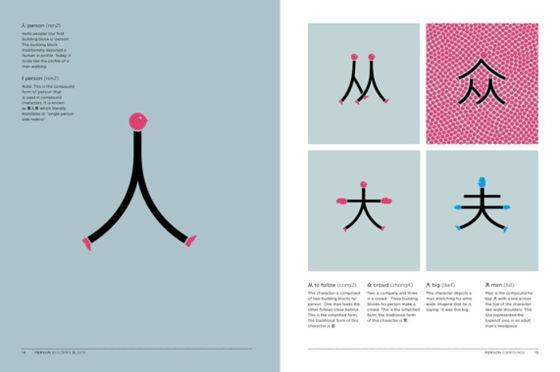DigMandarin’s Book Of the Month: Chineasy-The New Way to Read Chinese by ShaoLan
Hello Mandarin learners! This month’s Book review shall be on Shao Lan’s much awaited book-Chineasy! This new book continues and expands the content on the famous Facebook page “Chineasy”.

Thumbs Up
- Includes Both Traditional and Simplified Characters
- Soon available in multiple languages and countries
- Excellent tool for creating visual mnemonic devices for novice to intermediate learners
- Most recommended for visual learners, children and elder learners as a form of familiarizing with the Chinese characters.
Thumbs Down
- Does not teach how to write the characters or their stroke count for consulting the dictionaryMemorizing new characters from the pictures in the book may cause dependency on the illustrations, since the reader may not recognizethe written characters in books and other without the aid of the pictures.
- Although it shows examples of sentences with the words learned, it does not teach anything about syntax and grammar, since the great majority of the words are nouns.
Review
 This is not the first time DigMandarin.com has mentioned the work of Shao Lan, however it is the first time we actually saw her work concretized in an comprehensive form of all of her images.
This is not the first time DigMandarin.com has mentioned the work of Shao Lan, however it is the first time we actually saw her work concretized in an comprehensive form of all of her images.
Shao Lan first begins explaining the logic behind her work by distinguishing the “building blocks”,” compounds” and “phrases” in her scheme and how do they work together to create meaning. In this organizational method, pictograph-type characters are the foundation for understanding the written Chinese language, the so- called ” building blocks”. Using these basic characters, many more complex and abstract words can be formed, either through : having two simple words joined together to form pictophonetic characters such as 吗 (which uses 口 and 马) , where one word gives meaning and the other gives sound, or by having two pictograph characters joined together to provide a whole new different meaning, such as in 休, which combines 木 and 人, since in ancient times, most people would rest under trees after working in the field all day long. So after this introduction, the book begins teaching all of the 150 basic characters and another 250 characters derived from the original 250.
To let it be clear, Chineasy is not the first pictographic system of teaching Chinese characters. It is quite common to introduce pictographic characters with their representations to novice Western learners in order to familiarize them with reading words in visual characters, instead of in the Western alphabetical form. However, Chineasy goes further and shows how these foundational pictographic characters make up more complex characters, a very important lesson that many Western learners internally learn and comprehend as they transition into more abstract and complex words.
Personally, for me, as a Mandarin student, this book was a helpful tool. Although I am an intermediate- advanced student, I still have learned some new words and characters. However, many of the pictures used to elucidate the characters seemed quite unnecessary such as in the 人 or 火 characters, since they are quite self- evident to most learners by their general shape. In fact, here in Brazil, students remember characters like these , even if in different memorization processes. In other times, this ” word-assembly process” can be quite unnecessary and quite consuming of time The characters that us Westerners need the most help are the one that have similar appearances such as 我,找 and 钱. All three of these words have completely different meanings (I, to look for, money) ,yet at first sight for Westerners, they may look the same, confusing the reader. This event, in which I suffered so much for a long time, is what I call a “pseudo-dyslexia” for Chinese, in where the reader cannot differentiate some characters from others or are switched around in the view of the reader, such as in 找,我,and 钱. So I think that there still should be a bigger focus to help in the interpretation and reading of these tricky words, rather than of the easier words that can be memorized without the help of diagrams, even if the former are more difficult to come up with diagrams for.
Nevertheless, this can be a useful tool to learn more words, or even for simple entertainment, due to the beautiful illustrations and stories in Chinese within the book that use the characters taught in it.
Indications of ways to use
- Independent Study- This can be an excellent form for the independent Mandarin learner. If studied and read page by page in a steady daily basis, even an Advanced learner can find themselves learning new characters, either in Simplified or Traditional form.
- Tutoring and Teaching Children- One suggestion is to use the chapters of this book in each lesson, focusing on a new character each day. After introducing the new character and showing the words it can form, the child may then be allowed to do a drawing like one of the character illustrations to practice writing the words, after practicing the separate strokes required for the character.
- Teaching Adults-This is an excellent introductory for adult novice learners, especially Western readers with no previous language learning experience besides their mother tongue. Using this book will allow adults to come up with their own visual mnemonic devices for reading texts and remembering characters, while learning Chinese culture through the linguistic history behind the characters.
Recommended For
- Mandarin learners of all sizes and levels, either as review or as introduction to a new topic
However, it is most successful with children and visual learners
Where To Find





This Post Has 0 Comments